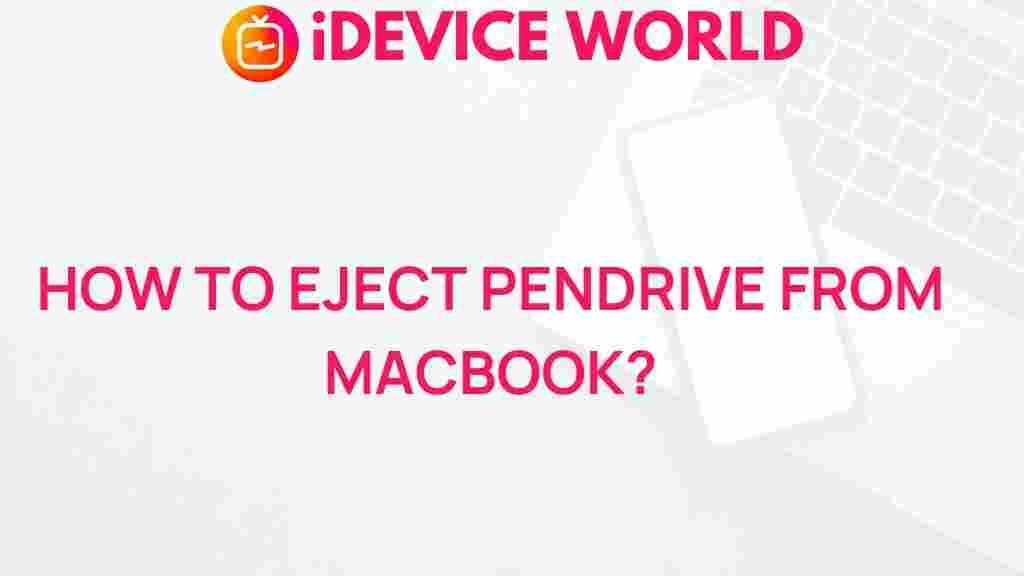Unleashing the Secrets of Ejecting a USB Drive from Your MacBook
As a MacBook user, managing your external devices like USB drives is crucial for maintaining your data’s integrity and ensuring smooth functionality. Knowing how to properly eject a USB drive from your MacBook can save you from potential data loss and hardware issues. In this article, we will explore the various methods to eject a USB drive, common issues you might encounter, and troubleshooting tips to resolve them.
Why Proper Ejection Matters
Before we dive into the methods for ejecting your USB drive, it’s important to understand why proper ejection is essential:
- Data Integrity: Ejecting a USB drive ensures that all data is saved and transferred correctly, preventing corruption.
- Hardware Protection: Improper ejection can lead to physical damage to the USB drive or the MacBook’s USB port.
- System Performance: Keeping your system organized and avoiding unnecessary errors can enhance your MacBook’s performance.
Methods to Eject a USB Drive from Your MacBook
Here are several effective methods to safely eject your USB drive:
1. Using Finder
The Finder is the easiest way to manage files and devices on your MacBook. Here’s how to eject your USB drive using Finder:
- Open Finder from the dock or by clicking on the desktop.
- Locate the USB drive in the sidebar under Devices.
- Right-click (or Control-click) on the USB drive icon.
- Select Eject “Drive Name”.
2. Using the Desktop
If you prefer a more visual method, you can eject your USB drive directly from the desktop:
- Look for the USB drive icon on your desktop.
- Drag the USB drive icon to the Trash (the Trash icon will change to an Eject icon).
3. Using Keyboard Shortcuts
For those who love shortcuts, you can eject your USB drive quickly:
- Select the USB drive in Finder or on the desktop.
- Press Command (⌘) + E on your keyboard.
4. Using the Eject Button
If your MacBook has an Eject key on the keyboard, you can use it:
- Make sure the USB drive is selected in Finder.
- Press the Eject key on your keyboard.
Troubleshooting Common Ejection Issues
Sometimes, you might encounter issues while trying to eject a USB drive from your MacBook. Here are some common problems and their solutions:
1. The Drive is In Use
If you receive a message stating that the drive cannot be ejected because it is in use, try the following:
- Close any applications that might be using files from the USB drive.
- Check Finder for any open windows or tabs that might be accessing the drive.
- Restart your MacBook if the problem persists.
2. Force Ejecting the USB Drive
If all else fails, you may need to force eject the USB drive:
- Open Terminal from Applications > Utilities.
- Type the command:
diskutil eject /Volumes/DriveName(replace DriveName with the name of your USB drive). - Press Enter.
3. Checking for System Errors
If you’re facing persistent issues with ejection, it might indicate underlying system problems. Consider these steps:
- Run Disk Utility to check and repair your USB drive.
- Update your macOS to the latest version for improved stability.
Preventing Future Ejection Problems
To avoid ejection issues in the future, consider the following tips:
- Regularly update your software: Keeping your MacBook and applications up to date can prevent compatibility issues.
- Safely eject drives after use: Always remember to eject your USB drive properly to maintain data integrity.
- Keep an eye on resource usage: Monitor applications that may be using the USB drive to prevent accidental usage during ejection.
Conclusion
Mastering the process of ejecting a USB drive from your MacBook is crucial for protecting your data and ensuring the longevity of your devices. By following the methods outlined in this guide, you can seamlessly manage your external drives without fear of data loss or hardware damage. Remember, proper ejection is not just a good practice; it’s essential for optimal performance and data safety. For more tips on MacBook usage, check out our other articles on MacBook Management Tips. If you’re interested in learning more about general USB drive maintenance, visit this helpful guide.
This article is in the category Guides & Tutorials and created by iDeciveWorld Team
